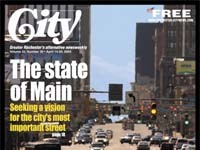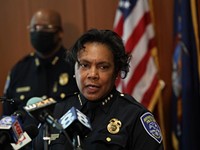[
{
"name": "500x250 Ad",
"insertPoint": "5",
"component": "15667920",
"parentWrapperClass": "",
"requiredCountToDisplay": "1"
}
]
Americans didn't much notice the death of philosopher Ivan Illich in Germany December 2. A priestly soul with the long view, Illich was a connoisseur of internal contradiction.
In Deschooling Society, for example, he wrote that traditional schools teach people "to confuse process and substance" and to assume that "the more treatment there is, the better are the results; or [that] escalation leads to success." The critique, or provocation, was comprehensive: "Medical treatment," said Illich, "is mistaken for health care, social work for the improvement of community life, police protection for safety, military poise for national security, the rat race for productive work."
The business about police and safety resonates today in Rochester --- not least because local authorities recently conducted a large experiment that seemed to contradict Illich absolutely.
From mid-October to early December, the Rochester Police Department joined forces with New York State Troopers and Monroe County sheriff's deputies to patrol certain "high-crime" city neighborhoods. Three areas were chosen within "the Crescent," a zone of poverty that curves through parts of southwest, northwest, and northeast Rochester. Officials, like the entire community, were especially worried about a rising homicide rate. Indeed, the number of homicides in the city had risen to 42 from a 1999 low of 29, said a New York Times end-of-year report on Upstate cities that singled out Rochester for special attention. (The RPD subsequently nailed down the 2002 total at 41.)
The 50 members of the temporary detail focused on drug-related crimes, illegal guns, and stolen vehicles. An RPD wrap-up analysis says that over the two months, the detail made 822 arrests, confiscated 28 firearms, recovered 11 stolen vehicles, and seized around five kilos of marijuana and almost a kilo of cocaine.
The numbers sound high, even without points of reference. But the RPD emphasized the degree to which the detail suppressed crime. Murders, says the RPD analysis, were down 75 percent in the targeted "detail areas" compared to the preceding six weeks, and down 67 percent compared to October-through-December 2001. There were notable decreases in assaults and "shots fired," as well --- though oddly, robberies within the detail areas actually shot up 27 percent compared to the same period the year before. (More oddly still, the rise in robberies within the detail areas was contradicted, so to speak, by a 12 percent decline in robberies citywide.)
The detail wrote 2,030 traffic tickets, as well. Of these, 122 were issued for "AUO" (aggravated unlicensed operation of a motor vehicle), and 26 were issued for DWI. So all but relatively few of the tickets were for minor offenses.
But did the increase in robberies within the detail areas mean that some kind of displacement was occurring --- that offenders were just moving from the street corners to places where they wouldn't be observed?
No, or at least probably not, says RPD Deputy Chief Robert Maldonado. "I don't know if we can explain why" robberies went up, he says. The details operated only between 7 p.m. and 3 a.m., he says, and you'd have to comb through arrest records to see if the robberies were being committed during those hours or at other times.
(Of course, the offenders could be adjusting their schedules as well as their "theaters of operation.")
Was the detail a success?
"We certainly think it was," says Maldonado. Beyond the mostly plunging crime stats, the effort addressed "the fear of crime, the perception," he says. Moreover, he says, "there's hope that we'll be able to do this in the future --- I just don't know how frequently." (A state police spokesperson from Troop E, based in Canandaigua, declined to comment and referred calls to the RPD.)
Maldonado, who put in 21 years as a New York State trooper before joining the RPD this past August, says state police have been working cooperatively with locals for some time. (All levels of police routinely collaborate on investigations but don't often patrol together.) In the last five years or so, he says, troopers have run "community stabilization teams" in Poughkeepsie, Newburgh, and other cities with poverty problems and small police forces.
A recent New York Times report said Syracuse officials have asked state police for help in nailing people with outstanding arrest warrants. But what's happening there, says SPD spokesperson Sgt. Tom Connellan, "is not even close to what [Rochester is] doing."
"Our shootings have gone way, way down" without extraordinary measures, Connellan says. "We created our own gang task force within the department." The task force, he says, combines the narcotics squad with the traffic division and other parts of the SPD.
So Rochester-style details are uncommon. But are they effective over the longer haul?
To hear Deputy Chief Maldonado, the judgment is out. He refers to a study done on the effects of heightened foot patrols in Newark, New Jersey. The study, he says, found the foot patrols did not lower the crime rate. But they did lower citizens' fear of crime. That's vital, he says. "We're peacekeepers; we have to make certain that people feel safe."
One man who lives in the Crescent is of two minds about the joint detail. "I don't know if it had any impact, to be honest with you," says Robert "Djed" Snead, a Roycroft Drive resident who's a board member of Group 14621, a northeast neighborhood association. "I'm just glad I didn't get stopped," he says.
Snead, a county social services employee, says an increased police presence usually means "hassles" for neighbors. "Any time you have more officers in the field," he says, "they want to find something to do."
Nevertheless, Snead speaks well of deployments apart from the joint detail. It's been "very, very helpful," he says, to have officers meet with his block club. "We've had positive results, good relationships with the police," he says. "I believe Chief Duffy and [other commanders] are serious about making a difference."
Joan Roby-Davison, head of Group 14621, has weighed the pros and cons, too. "I did an informal survey," she says. "Everybody was absolutely thrilled to have additional police around."
But she spots a downside. "I think there's a danger," she says. "I hate it when neighborhoods get identified as 'high-crime.' For the most part, this is not a dangerous neighborhood." People in the drug business, she says, are the ones who get caught up in violence. "It's a very small percentage of people that cause chaos."
What's Roby-Davison's bottom line? The joint detail model, she says, "is not a solution in and of itself, not a long term solution --- but it's a tool."
Insiders and outsiders fall on both sides of this issue.
Multi-media journalist Bob Lonsberry, for example, crows on his website about "the cavalry coming over the hill." He congratulates the state troopers and county sheriff's office for loaning their officers, paying for them, and being "willing to ride to the rescue to save Rochester lives."
Across the ideological divide, Judicial Process Commission leader Clare Regan is positive in her own way. "I don't think it's a bad thing, frankly," she says. "There's a legitimate case for more police in the country --- as long as they don't violate people's rights." She adds she has "a problem" with saturation patrols, surveillance cameras, and other excessive means. And she hopes for more systemic solutions, like "taking the killing and profit out" by legalizing and regulating drugs.
Weeks after results of the detail were released, Police Locust Club head Ron Evangelista is livid as ever. "We voted against metro police in 1982, so why the fuck are we doing it [in effect]?" he asks. "I was offended by it," he says. "I think they're blowing smoke up my ass."
Evangelista makes it clear he's not criticizing the officers who participated. "Cops are cops," he says, "and we're going to work together." But he believes the RPD, given enough resources, could have done the job by itself. Moreover, he charges that the state police lack the kind of diversity training that's needed to interact with poor, largely minority neighborhoods. "How many Black troopers do your know?" he asks. "How many Hispanics?"
The union leader also wonders about the seasonal timing. The experiment should have been done in July or August, if at all, he says: "People go out there in the cold weather and interact with, what, Eskimos?"
The RPD's Maldonado responds that the state police are not the "rural police force" of stereotype. He says troopers operate now in all the cities, and the joint detail has several Latino and Black members.
But did the experiment have any bad effect on constitutional rights? Scott Forsyth, counsel to the local chapter of the New York Civil Liberties, says no, with some caveats.
"The joining of police forces doesn't raise any civil liberties issue," providing arrests aren't done "on the basis of race, creed, etc.," Forsyth says. But targeting certain areas and thus ignoring others may "raise certain serious policy questions," he says. "Policing is a self-fulfilling prophecy: The more you police a neighborhood, the more arrests you make, and the worse it looks." He recalls that a recent NYCLU study of "FIFs" --- the field information forms on which city police officers record the details of their interactions with citizens --- said much the same.
The whole package ultimately is thrown back into the world of philosophy --- and of course, politics.
More coordination and combination of police forces may be coming in the future, says Rochester Institute of Technology criminal justice professor John Klofas. Federal courts are taking things on "that they never touched before," he says, especially related to guns and drugs. Part of the attraction comes from the stiffer sentences and less stringent rules of evidence that federal law can provide. (Compare "Project Exile," a tough-on-crime response to illegal gun possession.)
Joint police actions, says Klofas, are sometimes tried "when mayors get exasperated" and local police are ineffective. But the Rochester joint detail, he says, didn't stem from that sort of top-down intervention. Here, he says, the participants had a "collegial sense of working together on something."
Still, the relevant issues will be with us for a long time, says Klofas. For example, the need (real or perceived) to bring in troopers and deputies might buttress the case for hiring more local police.
In any case, as Klofas says, there must be fairness. In particular, authorities must avoid a double standard he describes: implied "permission to police some neighborhoods in a way that wouldn't be accepted in other neighborhoods."
That kind of tendency --- would Illich coin a neat phrase for it? --- can seep into other parts of the system, as well.
Rochester Mayor Bill Johnson, for example, seemed exasperated at one outcome of the joint detail: the quick release on bail of most of the 800-plus arrestees. He told WOKR-TV news that this was "unacceptable." He also said (as paraphrased in the report) that "the police make arrests and the judges put them back on the streets." The report said the mayor "plans to appeal to the judicial system to make the changes necessary to help solve the problem."
Johnson did not return calls for comment. "Sometimes I think the mayor says things that he should regret later," says Scott Forsyth, recalling that Johnson responded with similar impatience to the NYCLU report on FIFs.
And, of course, it's not only civil liberties groups that say the right to bail --- and to be treated the same as others charged with a similar crime --- ought to be sacrosanct.
Speaking of Police, state Troopers
Latest in News
More by Jack Bradigan Spula
-

The state of Main
Apr 14, 2004 -
School improvement: the price is wrought
Apr 7, 2004 -
Hour of power
Mar 31, 2004 - More »









